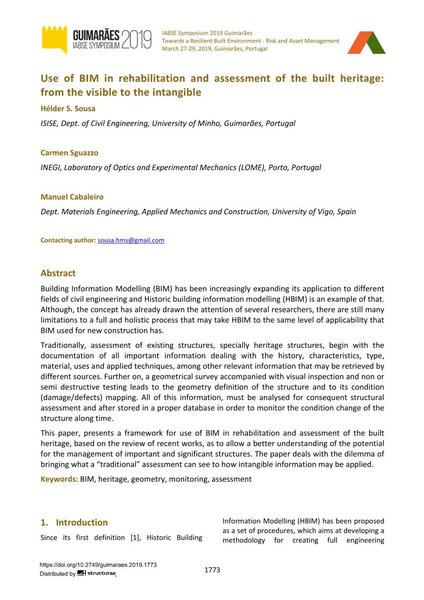Use of BIM in rehabilitation and assessment of the built heritage: from the visible to the intangible

|
|
|||||||||||
Bibliografische Angaben
| Autor(en): |
Hélder S. Sousa
Carmen Sguazzo (INEGI, Laboratory of Optics and Experimental Mechanics (LOME), Porto, Portugal) Manuel Cabaleiro (Dept. Materials Engineering, Applied Mechanics and Construction, University of Vigo, Spain) |
||||
|---|---|---|---|---|---|
| Medium: | Tagungsbeitrag | ||||
| Sprache(n): | Englisch | ||||
| Tagung: | IABSE Symposium: Towards a Resilient Built Environment Risk and Asset Management, Guimarães, Portugal, 27-29 March 2019 | ||||
| Veröffentlicht in: | IABSE Symposium Guimarães 2019 | ||||
|
|||||
| Seite(n): | 1773-1780 | ||||
| Anzahl der Seiten (im PDF): | 8 | ||||
| DOI: | 10.2749/guimaraes.2019.1773 | ||||
| Abstrakt: |
Building Information Modelling (BIM) has been increasingly expanding its application to different fields of civil engineering and Historic building information modelling (HBIM) is an example of that. Although, the concept has already drawn the attention of several researchers, there are still many limitations to a full and holistic process that may take HBIM to the same level of applicability that BIM used for new construction has. Traditionally, assessment of existing structures, specially heritage structures, begin with the documentation of all important information dealing with the history, characteristics, type, material, uses and applied techniques, among other relevant information that may be retrieved by different sources. Further on, a geometrical survey accompanied with visual inspection and non or semi destructive testing leads to the geometry definition of the structure and to its condition (damage/defects) mapping. All of this information, must be analysed for consequent structural assessment and after stored in a proper database in order to monitor the condition change of the structure along time. This paper, presents a framework for use of BIM in rehabilitation and assessment of the built heritage, based on the review of recent works, as to allow a better understanding of the potential for the management of important and significant structures. The paper deals with the dilemma of bringing what a “traditional” assessment can see to how intangible information may be applied. |
||||
| Stichwörter: |
Geometrie Bewertung BIM Monitoring
|
||||
